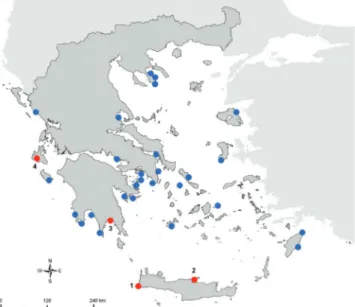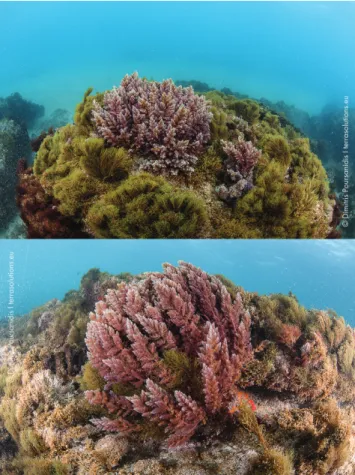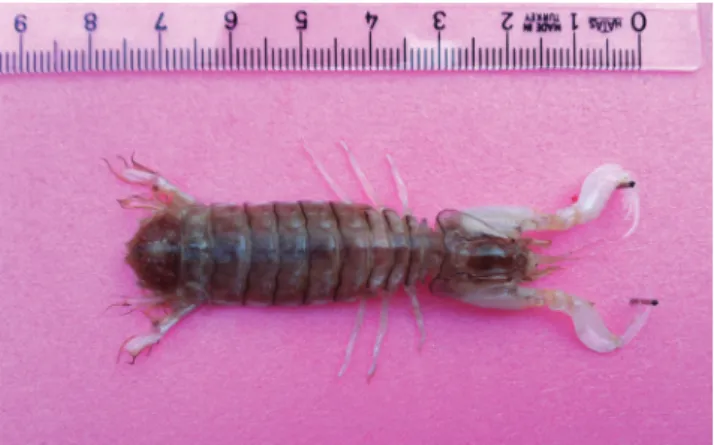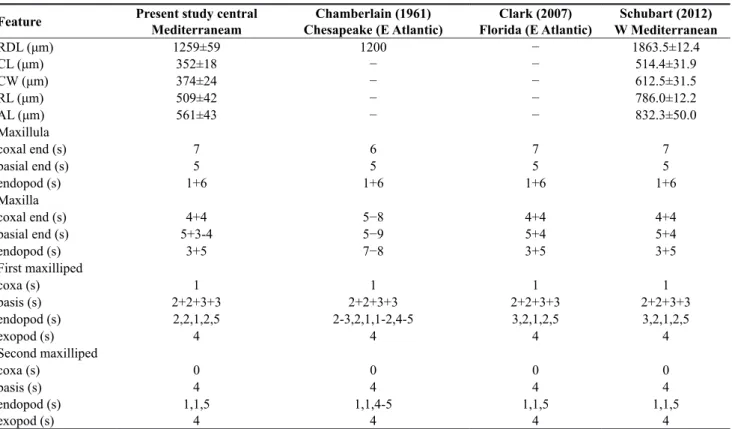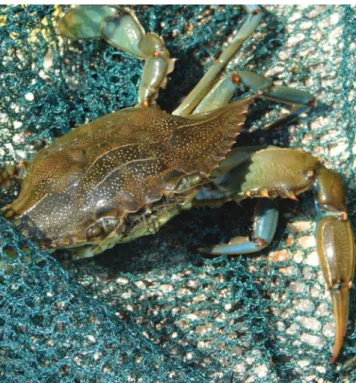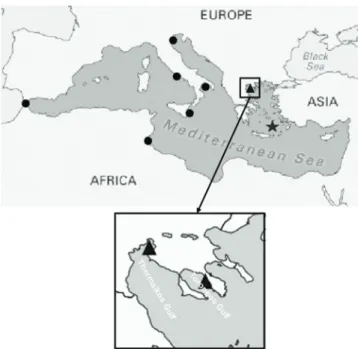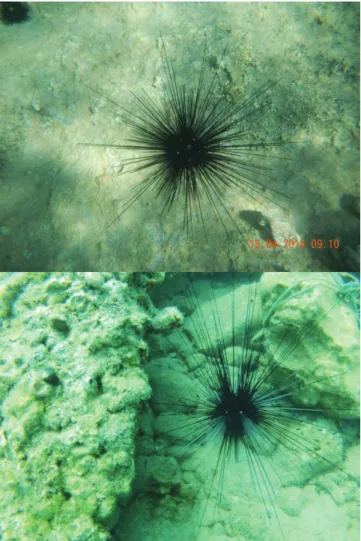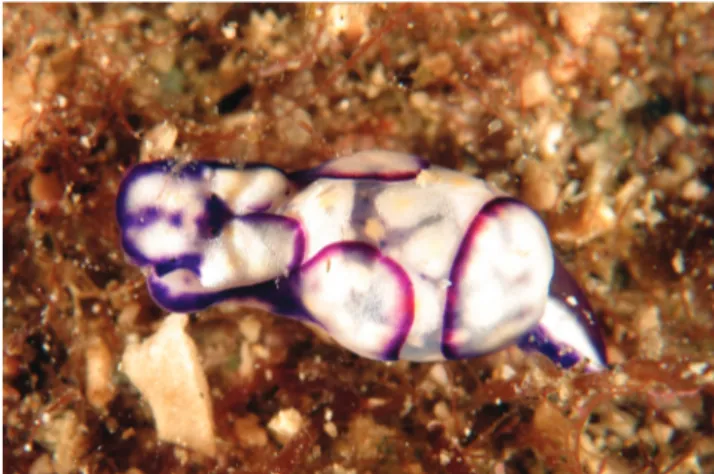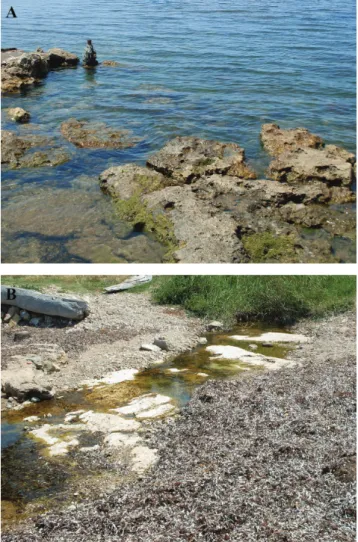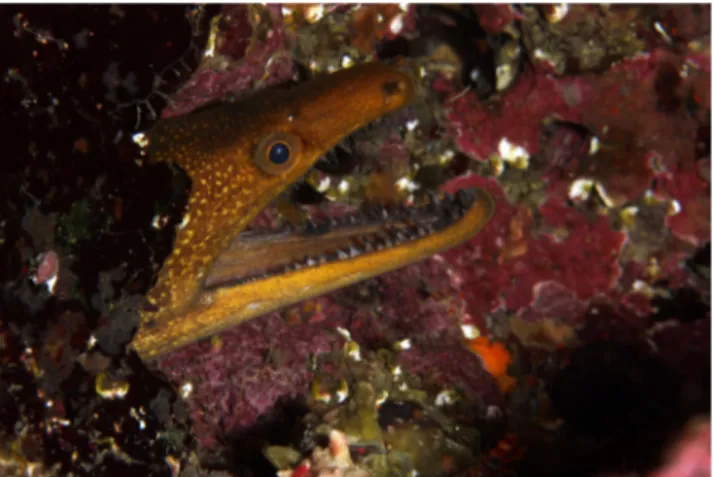New Mediterranean Biodiversity Records (October, 2014)
S. KATSANEVAKIS1, Ü. ACAR2, I. AMMAR3, B.A. BALCI4, P. BEKAS5, M. BELMONTE6, C.C. CHINTIROGLOU7, P. CONSOLI8, M. DIMIZA9, K. FRYGANIOTIS7, V. GEROVASILEIOU7, V. GNISCI10, N. GÜLŞAHIN2, R. HOFFMAN11, Y. ISSARIS12, D. IZQUIERDO-GOMEZ13, A. IZQUIERDO-MUÑOZ14, S. KAVADAS5, L. KOEHLER15, E. KONSTANTINIDIS16, G. MAZZA17, G. NOWELL18, U. ÖNAL19, M.R. ÖZEN20, P. PAFILIS21, M. PASTORE6, C. PERDIKARIS16, D. POURSANIDIS1,22, E. PRATO6, F. RUSSO23, B. SICURO24, A.N. TARKAN2,
M. THESSALOU-LEGAKI21, F. TIRALONGO10, M. TRIANTAPHYLLOU9, K. TSIAMIS25, S. TUNÇER19, C. TURAN26, A. TÜRKER2 and S. YAPICI2
1 University of the Aegean, Department of Marine Sciences, 81100 Mytilene, Greece 2 Muğla Sıtkı Koçman University, Faculty of Fisheries, 48000, Kötekli, Muğla, Turkey
3 Tishreen University, High Institute of Marine Research, Syria 4 Akdeniz University, Fisheries Faculty, Antalya, Turkey
5 Institute of Marine Biological Resources and Inland Waters, Hellenic Centre for Marine Research (HCMR), Anavyssos 19013, Attica, Greece
6 Institute for Coastal Marine Environment, CNR, Via Roma 3, 74123 Taranto, Italy
7 School of Biology, Department of Zoology, Aristotle University of Thessaloniki, Gr-54124 Thessaloniki, Greece 8 ISPRA, Italian National Institute for Environmental Protection and Research, Laboratory of Milazzo,
via dei Mille 44, 98057 Milazzo (ME), Italy
9 Faculty of Geology & Geoenvironment, University of Athens, Panepistimiopolis 15784, Athens, Greece 10 Laboratory of Experimental Oceanology and Marine Ecology – DEB, University of Tuscia,
Civitavecchia (RM), 00053, Italy
11 Department of Molecular Biology and Ecology of Plants, Tel-Aviv University, Tel-Aviv 69978, Israel 12 Institute of Marine Biology, Genetics and Aquaculture, Hellenic Centre for Marine Research,
71003 Heraklion, Crete, Greece
13 Departamento de Ciencias del Mar y Biología Aplicada, Universidad de Alicante, 03080 Alicante, Spain 14 Centro de Investigación Marina de Santa Pola (CIMAR), Universidad de Alicante-Ayuntamiento de Santa Pola,
03130 Santa Pola, Alicante, Spain 15 University of Malta, Faculty of Law
16 Department of Fisheries, Region of Epirus, P. Tsaldari 18, 46100 Igoumenitsa, Greece 17 Consorzio Plemmirio, Via Gaetano Abela, 2, 96100, Siracusa, Italy
18 Sharklab Malta, 404 Sqaq il-Forn, Hamrun, Malta, HMR 1961
19 Çanakkale Onsekiz Mart University, Faculty of Marine Sciences and Technology, Terzioğlu Campus, 17100, Çanakkale, Turkey 20 Suleyman Demirel University, Fisheries Isparta
21 Section of Zoology and Marine Biology, Department of Biology, University of Athens, Panepistimiopolis, 15784 Athens, Greece 22 Foundation for Research and Technology - Hellas (FORTH), Institute of Applied and Computational Mathematics,
N. Plastira 100, Vassilika Vouton, 70013, Heraklion, Greece
23 Ente Fauna Marina Mediterranea - Sede Campana, Viale dei Pini, 12, I-80065 Sant’Agnello, Napoli, Italy 24 Department of Veterinary Sciences, University of Torino, Largo Braccini 1, 10095, Gugliasco (TO), Italy 25 Institute of Oceanography, Hellenic Centre for Marine Research (HCMR), Anavyssos 19013, Attica, Greece
26 Mustafa Kemal University, Faculty of Fisheries, Turkey
Abstract
The Collective Article ‘New Mediterranean Biodiversity Records’ of the Mediterranean Marine Science journal offers the means to publish biodiversity records in the Mediterranean Sea. The current article is divided in two parts, for records of alien and native species respectively. The new records of alien species include: the red alga Asparagopsis taxiformis (Crete and Lakonikos Gulf, Greece); the red alga Grateloupia turuturu (along the Israeli Mediterranean shore); the mantis shrimp Clorida albolitura (Gulf of Antalya, Turkey); the mud crab Dyspanopeus sayi (Mar Piccolo of Taranto, Ionian Sea); the blue crab Callinectes sapidus (Chios Island, Greece); the isopod Paracerceis sculpta (northern Aegean Sea, Greece); the sea urchin Diadema setosum (Gökova Bay, Turkey); the molluscs Smaragdia souverbiana, Murex forskoehlii, Fusinus verrucosus, Circenita callipyga, and Aplysia dactylomela (Syria); the cephalaspidean mollusc Haminoea cyanomarginata (Baia di Puolo, Massa Lubrense, Campania, southern Italy); the topmouth gudgeon Pseudorasbora parva (Civitavecchia, Tyrrhenian Sea); the fangtooth moray Enchelycore anatina
Collective Article Mediterranean Marine Science
Indexed in WoS (Web of Science, ISI Thomson) and SCOPUS The journal is available on line at http://www.medit-mar-sc.net DOI: http://dx.doi.org/10.12681/mms.1123
Introduction
To gain a better understanding of the functioning of marine ecosystems and effectively manage them in an era of global change and cumulative anthropogenic pressures, there is a need for good spatio-temporal knowledge of the region’s biota at the relevant scales. Although the state of knowledge of marine biota at the taxonomic level (i.e. re-gional species lists) is relatively high for the Mediterranean in most regions and for most eukaryotic groups, in compari-son to most other seas (Coll et al., 2010), accurate informa-tion about the geographical distribuinforma-tion of marine species is scant (Levin et al., 2014). Furthermore, the high rates of new introductions of alien species and the continuous expansion of their range (Katsanevakis et al., 2013a) require continuous efforts for monitoring and reporting their occurrence. Such information is vital to assess the impacts of alien species and their role in the ongoing changes of biodiversity patterns in the Mediterranean Sea (Katsanevakis et al., 2014).
Collecting detailed biodiversity data and mapping spatial patterns of marine biodiversity across large spa-tial scales is challenging, and usually requires extensive and expensive sampling. Often, such information remains in the grey literature and thus is largely unavailable to the scientific community. The Mediterranean Marine Science journal, recognizing the importance of archiving records of species found in the Mediterranean Sea, offers the means to publish biodiversity records through its Collective Article ‘New Mediterranean Biodiversity Records’. Submissions to the Collective Article are peer-reviewed by at least one reviewer and the editor, and the contributors of records are co-authors, their names appearing in alphabetical order. The present article is divided into two main sections, the first for non-native and cryptogenic species, and the second for native species. The contributing authors are also cited at the beginning of the sub-section corresponding to their record. Biodiversity Records
1. Non-native and cryptogenic species
1.1. First record of the red alga Asparagopsis taxiformis (Delile) Trevisan de Saint-Léon from Crete Island and the Lakonikos Gulf (Greece)
By D. Poursanidis and K. Tsiamis
Asparagopsis taxiformis (Delile) Trevisan de Saint-Léon (referring to the morphospecies complex sensu lato as
pan-tropic - Andreakis et al., 2009) is included in the list of the 100 “Worst Invasives in the Mediterranean Sea” (Streftaris & Zenetos, 2006), exhibiting invasive behaviour in many re-gions, including the Greek seas (Tsiamis et al., 2010, 2013).
A. taxiformis was first reported from Greece in 2003 from Rhodes Island (Tsiamis, 2012), and during the last decade a rapid expansion has been recorded along the Greek coasts - the species being reported from the Ionian and the North Aegean Seas, the Cyclades and the Dodec-anesos complex (Tsiamis, 2012; Fig. 1). Up to date, no information is available on its distribution in the Cretan Sea, and the nearby Lakonikos Gulf (SE Peloponnesus).
After a thorough investigation of the coastal area in the north of Heraklion County, in front of the Natural His-tory Museum of Crete in May 2014, an area close to the port of Heraklion (35.342429°, 25.127565°), an estab-lished population of A. taxiformis was recorded and pho-tographed (Fig. 2) by means of free diving. More than 50 individuals (thalli) were counted in the investigated area (300 m2) at 2 m depth. Thalli were attached mainly to the edges of the rocky substratum, accompanied by the brown algae, Dictyota spp. and Cystoseira spp., the green algae Ulva spp., as well as by the alien crab Percnon gibbesi (H. Milne Edwards, 1853). A few thalli of A. taxiformis were also detected in Elafonisos (35.26922°Ν, 23.54055°Ε), Western Crete (Fig. 1), in April 2013. Plants were grow-ing on rocks at 1 m depth, among luxuriant Cystoseira (Plemmirio marine reserve, Sicily); the silver-cheeked toadfish Lagocephalus sceleratus (Saros Bay, Turkey; and Ibiza channel, Spain); the Indo-Pacific ascidian Herdmania momus in Kastelorizo Island (Greece); and the foraminiferal Clavulina multicam-erata (Saronikos Gulf, Greece). The record of L. sceleratus in Spain consists the deepest (350-400m depth) record of the species in the Mediterranean Sea. The new records of native species include: first record of the ctenophore Cestum veneris in Turkish marine waters; the presence of Holothuria tubulosa and Holothuria polii in the Bay of Igoumenitsa (Greece); the first recorded sighting of the bull ray Pteromylaeus bovinus in Maltese waters; and a new record of the fish Lobotes surinamensis from Maliakos Gulf.
Fig. 1: Asparagopsis taxiformis distribution range along the
Greek coasts. Blue dots denote published records based on Tsiamis (2012), while red dots denote the new regional find-ings (1 - Elafonisi, 2 - Heraklion, 3 – Gytheio, 4 - Kefallonia).
spp. populations. A single thallus was found at Gytheio (36.75450°Ν, 22.57275°Ε, Lakonikos Gulf, SE Pelopon-nesus) in May 2013, growing on rocky substratum at 0.5 m depth, among dense Ellisolandia elongata (J. Ellis & Solander) K.R. Hind & G.W. Saunders populations (Fig. 1). Lastly, specimens have been spotted in Argostoli, Ke-fallonia, in 1 m depth on rocky substrate.
Finally, it should be noted that at least two cryptic taxa of different origin coexist under the name of A. taxiformis in the Mediterranean Sea: one of Atlantic origin, known in the Mediterranean from the early 19th century, and one of Indo-Pacific origin that corresponds to a recent introduc-tion in the Mediterranean Sea (Andreakis et al., 2009). On the basis of recent records, the Greek populations probably belong to the invasive Indo-Pacific strain (Tsiamis, 2012). 1.2. First record of Grateloupia turuturu Yamada
(Ha-lymeniales, Rhodophyta) in the Eastern Mediter-ranean Sea
By R. Hoffman
The genus Grateloupia C. Agardh, with over 90 spe-cies currently accepted taxonomically is the largest in the family Halymeniaceae. It is highly distributed in the Indi-an, Pacific and Atlantic oceans; however, some species are also found in the Western and Central Mediterranean Sea
as well as the Adriatic Sea (Guiry & Guiry, 2014). Six of them are regarded as non-native species having arrived in the Mediterranean through aquaculture (Hoffman, 2013).
During a continuous algal survey conducted along the Israeli Mediterranean shore, twenty five gametophyt-ic and tetrasporophytgametophyt-ic specimens of Grateloupia turu-turu Yamada (Fig. 3) were collected exclusively at Zikim Beach (31.61248oN, 34.50388oE), near the border with the Gaza Strip, in late winters of 2013 and 2014. Most of them were found scattered in the algal drift washed ashore and one was found attached to kurkar conglomer-ate rock at 1.5 m depth. Zenetos et al. (2010) indicconglomer-ate that this is the first record of the Genus Grateloupia from the Levant Mediterranean Sea.
Morphological and cellular features of samples examined are in agreement with those published by Figueroa et al. (2007) and Verlaque et al. (2005). The thallus is mostly composed of several elongate blades (Fig. 3) up to 16 cm long, rising from a discoidal hold-fast ~5 mm in diameter; stipe 5-13 mm long; blade brownish-red or crimson, soft and slippery (gelatinous) in texture, strongly adherent to paper, 0.6-3 cm wide and 120-220 μm thick; blade of tetrasporophyte mostly un-divided, with frequent marginal proliferations, tapering towards the apex; gametophyte composed of undivided blades, broadly expanded from the base and irregularly lobed at the apex, with cleft margins. Structure multiaxi-al, thallus consisting of a cellular cortex and a very loose filamentous medulla (Fig. 4); cortex 20-40 µm thick, composed of 3-4 layers of small pigmented and rounded cells decreasing progressively in size towards the thallus surface; medulla transparent, 80-140 µm thick. Cysto-carps spherical, 150-200 µm in diameter, located inside the medulla and scattered mostly in the middle part of the blade. Trasporangia are divided cruciately, 29-35 µm long and 18-26 µm wide, scattered over the blade, aris-ing from the cortical cells.
Fig. 2: Asparagopsis taxiformis among brown macroalgae in
Heraklion, Crete Island (photo by D. Poursanidis).
Fig. 3: Tetrasporophyte specimen of Grateloupia turuturu.
No-tice the proliferation of some blades and the greenish coloration, which is due to a few moments of preservation in alcohol.
Grateloupia turuturu is reported for the first time in the Eastern Mediterranean Sea. The species spread to the West-ern Mediterranean Sea through oyster aquaculture; however, as there are no oyster farms along the Israeli coast, it might have arrived in the Eastern Mediterranean through shipping. 1.3. A new record of the Indo-West Pacific mantis
shrimp, Clorida albolitura Ahyong & Naiyanetr, 2000 (Stomatopoda, Squillidae) in the Gulf of An-talya, Turkey
By B. A. Balci and M.R. Özen
Clorida albolitura Ahyong & Naiyanetr, 2000 (Fig. 5), is a member of the Squillidae family. The native dis-tribution area of C. albolitura is Taiwan, North-east Aus-tralia, West Indian Ocean and Madagascar. The presence of this species in the Red Sea is unclear. C. albolitura was recorded for the first time on the Ashdod coast of Israel, eastern Mediterranean (Levantine Sea) (Ahyong and Galil, 2006), and subsequently in the Gulf of Iskend-erun, Turkey (Galil et al., 2009).
The specimen reported herein was caught during a bot-tom trawl operation carried out on 31 January 2014. The operation was conducted with R/V “Akdeniz Su” of the Akdeniz University Fisheries Faculty, Antalya-Turkey. The trawl operation occurred between 36.60448oN, 31.69847oE and 36.81583oN, 31.04722oE, at 25-30 m depths, ap-proximately two miles offshore in the Gulf of Antalya. The specimen was photographed and preserved in a formalin so-lution. Species identification was made using the key given by Ahyong and Naiyanetr (2000) and Ahyong (2001). The preserved specimen was labelled and added to the Akdeniz University Fisheries Faculty Marine Museum (Nr. 140).
The effects of the lessepsian crustacean C. albolitura on the marine ecosystem and on fisheries are still unclear.
How-ever, another west-indopacific alien stomatopod (E. mas-savensis) that is more abundant and has expanded in the east-ern Mediterranean (Gökoğlu & Oray, 1997; Ahyong & Galil, 2006) causes problems to fishing gears and fishermen, who have to spend more time on cleaning their gears (Gökoğlu & Oray, 1997). C. albolitura is even smaller than E. massaven-sis (Ahyong & Galil, 2006) and has no commercial use. Like E. massavensis, C. albolitura might also negatively affect the ecosystem and fishing activities in the area.
The present record, 1000-1500 km far from the pre-vious ones, is the third record of this species in the Medi-terranean Sea. It seems that the species has adapted to the Mediterranean ecosystem and its distribution area is expanding northward and westward.
1.4. On the occurrence of the mud crab Dyspanopeus sayi (Smith, 1869) in the central Mediterranean (Ionian Sea)
By M. Pastore, M. Belmonte and E. Prato
Dyspanopeus sayi (Smith, 1869) is a marine decapod species indigenous to the Atlantic coast of North America. It is considered an alien species for the Mediterranean (Galil et al., 2002) and was collected for the first time in the lagoon of Venice and in the Po River Delta (western Adriatic Sea) (Froglia & Speranza, 1993; Florio et al., 2008).
D. sayi have been collected by hand, on mussel cul-ture (Mytilus galloprovincialis Lamk.) from Mar Pic-colo of Taranto in the Ionian sea, central Mediterranean (40.475959oN, 17.26456oE). A total of 14 specimens were recorded in September 2011 (11 individuals) and May 2012 (3 ovigerous females). Males had sizes rang-ing from 18.3 to 24.5 mm (CW) and from 13.7 to 18.1 (CL) with a weight ranging from 2.05 to 5.04 g, smaller than specimens reported for Alfacs Bay (26.3 mm CW) (Schubart et al., 2012) (Fig. 6A). Females were smaller than males with a range of 15.9 to 21.0 mm (CW) and 12.5 to 16.3 mm (CL), and a weight of 1.4 – 2.6 g.
The ovigerous females showed eggs in an advanced stage of development. They have been kept in an
aquari-Fig. 4: Transverse-section of gametophyte blade showing
com-pact thin cortex and the loose filamentous medulla containing a cystocarp that has already released all carpospores (scale bar = 100µm).
um with well-aerated filtered seawater at a salinity of 36‰ and temperature of 18±2°C until hatching. The eggs, were linked by thin mucus, like bunches; the diameter were measured with an ocular micrometer and showed an aver-age diameter of 259 ± 15 microns (Fig. 6B,C).
The brood size was determined by counting the num-ber of eggs for each female. The main information on morphological characteristics of first zoea is reported in Table 1. No larva reached the second zoea stage.
The measurement characters of first zoea agreed with previous descriptions of larvae morphology from North American populations (Chamberlain, 1961; Clark, 2007) (Table 1; Fig. 6D, E), while few differences with
previ-ous studies were observed as regards the setation pattern. The introduction of this species in Mar Piccolo wa-ters is probably due to two main factors: shipping and the presence of mussel farms. Mar Piccolo is an impor-tant area for the region’s economy due to the presence of mussel culture. Dyspanopeus sayi were found on long-lines of commercial mussel farms and this is not surpris-ing, since this species actively feeds on adult sized bi-valves such as Mytilus galloprovicialis. In the Adriatic Sea, it has exterminated prey species such as Mytilus galloprovincialis, Mytilaster lineatus, Ostrea edulis and Crassostrea gigas in a very small locally restricted area (Mizzan, 1998). Although the data suggest a slow spread
Fig. 6: Male adult of Dyspanopeus sayi (A); eggs (B; C); first zoea: frontal (D) and lateral view (E).
Table 1. Morphological characteristics of first zoea. Abbreviations: RDL, rostrodorsal length; CL, carapace length; CW, carapace
width; RL, rostral spine; AL, antenna length (protopod process); s, setae.
Feature Present study central Mediterraneam Chesapeake (E Atlantic)Chamberlain (1961) Florida (E Atlantic)Clark (2007) W MediterraneanSchubart (2012)
RDL (μm) 1259±59 1200 − 1863.5±12.4 CL (μm) 352±18 − − 514.4±31.9 CW (μm) 374±24 − − 612.5±31.5 RL (μm) 509±42 − − 786.0±12.2 AL (μm) 561±43 − − 832.3±50.0 Maxillula coxal end (s) 7 6 7 7 basial end (s) 5 5 5 5 endopod (s) 1+6 1+6 1+6 1+6 Maxilla coxal end (s) 4+4 5−8 4+4 4+4 basial end (s) 5+3-4 5−9 5+4 5+4 endopod (s) 3+5 7−8 3+5 3+5 First maxilliped coxa (s) 1 1 1 1 basis (s) 2+2+3+3 2+2+3+3 2+2+3+3 2+2+3+3 endopod (s) 2,2,1,2,5 2-3,2,1,1-2,4-5 3,2,1,2,5 3,2,1,2,5 exopod (s) 4 4 4 4 Second maxilliped coxa (s) 0 0 0 0 basis (s) 4 4 4 4 endopod (s) 1,1,5 1,1,4-5 1,1,5 1,1,5 exopod (s) 4 4 4 4
of this invasive species northwards to the Central Medi-terranean Sea, it is necessary to maintain high vigilance in order to prevent its spread to the mussel-culture of Mar Piccolo and, thus, further investigation and good collabo-ration with local fisherman is required.
1.5. First record of Callinectes sapidus Rathbun, 1896 (Crustacea, Brachyura) from Chios Island, East-ern Aegean Sea
By M. Thessalou-Legaki and P. Pafilis
The blue crab (Callinectes sapidus) is a successful invasive species. Native to the waters of the western At-lantic Ocean (in both Americas), it was introduced to Eu-rope and Japan and has been repeatedly reported from the Mediterranean Sea (Zenetos et al., 2010). Although some specimens have been found in the western part of the Mediterranean Basin, the majority of the records come from the eastern side. Recent reports on the species in ar-eas adjacent to Greece include localities along the ar-eastern coastline of the Adriatic (Croatia and Albania) and the Italian coasts (Stasolla & Innocenti, 2014 and references therein). Towards the East, the species occurs all around Turkey: the Levantine, Aegean and Marmara Seas, with additional records from the Dardanelles and the Turkish Black Sea (Yaglioglu et al., 2014).
The first observations from Greek waters date from the mid 20th century. The actual distribution of the species in-cludes the Greek Ionian and Aegean coastlines. On the con-tinental coast of the Northern Aegean, especially in the inner Thermaikos Gulf, the species supports a recently increased fishery production, and can even be found in freshwater ecosystems. The insular documented range of the species is rather restricted. The presence of the blue crab has been con-firmed only for Crete, Rhodes and Corfu (ELNAIS, 2014). Here we enlarge the island list by adding the island of Chios. During a field survey on 19/8/2013, we encountered several individuals of C. sapidus in a small canal at the location Marmaro (Kato Kardamyla Bay, North Chios – 38.54073oN, 26.11214oE). The canal (maximum width 1.5 m) carries fresh water from Kardamyla hills and flows into the bay, mixing its waters with sea along the last me-ters of its length. We detected 12 individuals of C. sapi-dus at a distance of 50 m from the sea and easily captured a male individual with using fishing net at a depth of 0.4 m (Fig. 7). The bottom of the canal was muddy and the waters rather eutrophic, supporting dense algal vegeta-tion. The specimen had only one claw. It measured 65.67 mm in carapace length and 168.43 mm in carapace width (including lateral spines). Its total weight was 230.55 g.
The present finding indicates that the species invades any favourable site regardless of its dimensions, but it is suggested that its presence on the island is restricted due to estuarine habitat preference: a recent survey for marine alien species with fourteen stations around Chios at depths
0-10 m did not reveal its occurrence (Katsanevakis & Tsia-mis, 2009). Because of the scarcity and the small size of the estuarine habitats on the Aegean islands, and the unknown impact of such an invader on their fragile biota, a detailed record of the species on the islands is urgently needed. 1.6. First record of the isopod Paracerceis sculpta in
the Aegean Sea: established populations in north-Aegean marinas
By K. Fryganiotis and Ch. Ch. Chintiroglou
Paracerceis sculpta (Holmes, 1904) is a widely dis-tributed sphaeromatid isopod (Espinosa-Pérez & Hen-drickx, 2002). In the Mediterranean, it has been reported for the first time from the Lake of Tunis (Regiz, 1978); a few years later, from the Venice Lagoon (Forniz & Scon-fietti, 1983) and Sicily (Forniz & Maggiore, 1985), and nowadays the species is rather common near the Strait of Gibraltar (Castelló and Carballo, 2001). In the eastern Mediterranean P. sculpta has been assigned the status of an established alien species (Zenetos et al., 2010) with-out, however, information on either its distribution or population characteristics being available.
The present study constitutes the first report on P. sculpta in the Aegean Sea, providing also basal popu-lation characteristics (sex ratio, biometry) for its north-sector populations, to assess whether the species has been actually established in the area.
Populations of P. sculpta were found at 14 stations randomly located in two float marinas of the north Aegean Sea (Fig. 8), one in the Thermaikos Gulf (40.52272oN, 22.85386o E) and the other in Toroneos Gulf (40.13212oN,
Fig 7: Callinectes sapidus male from Kato Kardamyla Bay,
23.74361oE). Eighty-four dip-net samples were collected from the artificial substrata, in summer (2009 & 2010) and 584 P. sculpta (Fig. 9) individuals were identified (453 and 131 from Thermaikos and Toroneos, respectively; 100% frequency of occurrence in both marinas), suggesting flourishing populations. In Thermaikos, 62.91% of the col-lected individuals were males, and in Toroneos 58.78%. Eight (8) individuals collected from Thermaikos were identified as juveniles, suggesting the presence of a self-maintaining, reproducing population in the area. Males were much larger than females, whereas mean length by sex was rather similar between the two studied marinas (Table 2). It seems, therefore, that the species’ populations are well established in the surveyed, north Aegean, area.
Paracerceis sculpta is a relatively resistant organism (Espinosa-Pérez & Hendrickx, 2002), able to live in a wide temperature (13 to 29.8oC) and salinity range (28 to 46 psu). The species can live in both soft and hard substrata from very shallow waters to about 200 m depth. This broad ecological requirement seems to provide an extra reason of its wide global distribution.
In all cases, the occurrence of P. sculpta refers to ports, as a member of the fouling hard-substrata
com-Fig. 8: Distribution of Paracerceis sculpta in the Mediterranean
Sea (circles) and location of North Aegean records (triangles). In the East Mediterranean (star), the symbol does not corre-spond to the exact location.
Fig. 9: Morphological characteristics of Paracerceis sculpta (Holmes, 1904).
Table 2. Frequency of occurrence (F), number of individuals (N) and mean length of each sex of Paracerceis sculpta at two
loca-tions (Thermaikos and Toroneos Gulf).
Thermaikos Gulf Toroneos Gulf
F (%) N Mean Length (mm) F (%) N Mean Length (mm)
males 100 285 5,91±0,71 100 77 5,62±0,27
females 100 160 2,63±0,29 100 54 2,69±0,28
-munity. This signifies the importance of commercial and touristic navigation for its wide-scale distribution, ampli-fying the hypothesis that the species has been transport-ed mainly by hull fouling (Castelló & Carballo, 2001; Hewitt & Cambell, 2001). In the present study all indi-viduals were collected from small ports used mainly for touristic (most yachts coming from northwest Europe) and local fisheries purposes. Accordingly, the small-scale distribution of P. sculpta appears to be due to recreation-al boating. Considering the seascape of the Aegean Sea, i.e. extensive coastline, many islands and hundreds of closely related small marinas, as well as the expansion of cruising, further spread of the species may be predicted. 1.7. First record of the alien sea urchin Diadema seto-sum (Leske, 1778) (Echinodermata: Echinoidea: Diadematidae) from the Aegean Sea
By S. Yapici, Ü. Acar and A. Türker
The echinoderm Diadema setosum (Leske, 1778) is widely distributed in the Indo-West-Pacific Ocean, from the Red Sea and the east coast of Africa, to Japan and Australia (James and Pearse, 1971). The first record of D. setosum in the Mediterranean Sea was reported in 2006 off Kaş Peninsula, south-western coast of Turkey (Yokes & Galil, 2006), while its occurrence was ascertained along the Lebanese coastline in 2009 (Nader & Indary, 2011) and later, in 2010, at Antakya, south-eastern coast of Turkey (Turan et al., 2011). The species commonly prefers coralligenous formations, reefs and rocks, and oc-casionally may form large aggregations (Yokes & Galil, 2006; Nader & Indary, 2011). This cryptic and noctur-nal species is omnivorous and feeds mainly on detritus (James & Pearse, 1971).
On 13 April and 28 July 2014, two specimens of D. setosum were observed by SCUBA divers in Gökova Bay (36.91972oN, 28.17111oE and 37.04166oN, 28.25666oE), Turkey at a depth of 4 m. The specimens were photo-graphed and video recorded on rock covered by algae patches and sandy bottom. The videos were uploaded as an electronic reference and evidence for SeaLifeBase (Palomares & Pauly, 2014) and can be viewed online at http://www.youtube.com/watch?v= jvVc0bEkGMY and http://www.youtube.com/watch?v=bpF4mTvQAWg. The identification of the species was based on the de-scription provided by Coppard & Campbell (2006), using high quality photos and video recording.
The specimens had the five evident white iridophores on the mid-lines of the interambulacral and an orange ring around the periproctal cone, which are characteris-tic of the species (Coppard & Campbell, 2006) (Fig. 10). One of the observed specimens had only dark spines but no gray ones, while the other specimen had both dark and gray spines. This could be due to water depth, limited light penetration and technical limitations.
The species may aggregate dramatically forming massive colonies and its larvae can travel via water circulation, and then potentially invade western and/or northern sectors of the Mediterranean Sea. It is harmful for swimmers, fishermen and divers due to its venom re-leased from the long and slender spines (Yokes & Galil, 2006; Nader & Indary, 2011).
In conclusion, the occurrence of D. setosum is ex-pected in the Aegean Sea, a marine area affected by the introduction of non-native species due to lessepsian mi-gration, introductions by humans, water circulation pat-terns and present-day sea warming. Due to these poten-tial reasons, distribution and colonization features of D. setosum should be investigated and monitored urgently.
1.8. New records of alien Mollusca in Syria By I. Ammar
Mollusca is the phylum with most alien species in European Seas (Katsanevakis et al., 2013b), particular-ly so in the eastern Mediterranean (Nunes et al., 2014). However, relevant literature is scarce for some countries such as Syria (Ammar, 2004; Bitar et al., 2003).
Fig. 10: Specimens of Diadema setosum from the Aegean Sea
The present work reports on the finding of four alien molluscs, which are widespread in the Levantine basin, yet have not been recorded from the Syrian coast to the present day (Fig. 11). They were collected between 2003 and 2005, at various depths, either by hand or with a benthic sampling device (grab, dredge) within the framework of various re-search projects. To these, we should add the spotted sea hare Aplysia dactylomela (Fig. 11), a species of Atlantic origin whose pathway of introduction in the Mediterranean is de-batable (Valdes et al., 2013). Table 3 lists the species with details on their first finding location, substratum and depth. Nomenclature follows WoRMS Editorial Board (2014). 1.9. Going north: Haminoea cyanomarginata
(Gas-tropoda: Cephalaspidea: Haminoeidae) reaches Massa Lubrense (Naples, southern Italy)
By F. Russo
Haminoea cyanomarginata Heller & Thompson, 1983 is a cephalaspidean mollusc native to the Red Sea, from where it is only known from the original description. Its morphological identification is fairly easy, having a mantle bordered with purple or dark-blue and scattered vivid-yel-low blotches all over. Since 2001, it spread to the Mediter-ranean Sea, where it soon established viable populations in Greece (2001: Zenetos et al., 2009), Turkey (2002: Çinar et al., 2011), Malta (2006: Sciberras & Schembri, 2007) and Italy (2007: Crocetta, 2012). Despite the absence of re-cords from the far eastern Mediterranean, it has presumably
reached its new distributional area through the Suez Canal. During a field survey at Baia di Puolo (Massa Lubrense, Campania, southern Italy - 40.62666oN, 14.34194oE) on 08/09/2014, around thirty specimens of H. cyanomarginata (both solitary and in couples, show-ing trailshow-ing behaviour) were noted at 24-26 m of depth, mostly on a sandy bottom with filamentous algae (Fig. 12). A few days after, on 15/09/2014, two specimens were noted at 10 m depth. On 28/09/2014, around ten scattered specimens were noted at a depth of 12 to 24 m in the same area, predominantly on a rocky bottom.
So far, H. cyanomarginata was only known in Italy from the Calabrian shores of the Messina Strait area and
Fig. 11: Fusinus verrucosus (left), Murex forskoehlii (middle), and Aplysia dactylomela (right) from Syria.
Table 3. New records of alien molluscs in Syria.
Species area substratum depth abundance
Smaragdia souverbiana
(Montrouzier, 1863) Al- Bassit /2003 mud - gravel 5 -35 m few
Murex forskoehlii
(Röding, 1798) Lattakia/ 2005 mud-sand >30m few
Fusinus verrucosus (Gmelin, 1791) Lattakia/ 2004 mud 70 m common
Circenita callipyga (Born, 1778) Lattakia&Tartous/ 2003 mud 25 m rare
Aplysia dactylomela(Rang, 1828) Lattakia/2013 Rocky littoral 2 ind
Fig. 12: Haminoea cyanomarginata from Massa Lubrense
several sites all around Sicily (review in Stasolla et al., 2014). Therefore, the present records considerably ex-pand its known Italian distribution by >200 km to the north, up to Campania. Secondary natural dispersal from the previously known areas seems to be the most proba-ble pathway, additionally suggesting an overlooked pres-ence all around the southern Tyrrhenian shores.
1.10. The presence of Pseudorasbora parva (Temminck & Schlegel, 1846) in marine waters: a record in the Tyrrhenian Sea
By F. Tiralongo and V. Gnisci
Pseudorasbora parva, commonly known as top-mouth gudgeon or stone moroko, is a small cyprinid species native to the East Asia (Japan, China, Korea and River Amur catchment). Common size range is between 5 and 8 cm (TL). It is a freshwater fish that occurs in rivers, lakes and well vegetated small channels. This spe-cies feeds mainly on zooplankton. In Europe, P. parva was recorded for the first time in Romania, 1960-1961 (Banarescu, 1999), where it was accidentally introduced. After this first introduction, this invasive species is now present in many European and Asian countries. In some countries, such as France and Albania, however, the spe-cies was intentionally introduced as food for predatory fisheries reared in hatcheries. In Italy, the first records come from 1988 (Sala & Spampanato, 1991) and con-cern mainly the basin of the Po river and Tuscany (Van-ni et al., 1997). P. parva is considered a very invasive species mainly because of its life history characteristics (reproductive behaviour, early sexual maturity, ability to spawn on any smooth surfaced object) (Gozlan et al., 2002). This species is furthermore considered an alimen-tary competitor for some populations of European indig-enous species. In summer 2014 (June 24), during hand-net sampling in the Tyrrhenian Sea (Civitavecchia), we caught this freshwater fish in marine waters (42.14720 N, 11.74397 E), near the mouth of a small stream (42.14740 N, 11.74451 E). A school of fishes were swimming close to the sea surface, at about 0.5 m depth, over a Cymodo-cea nodosa bed. Salinity and temperature was 33.8 and 25.1°C in marine waters and 0.6 and 21.3°C in stream waters, respectively. Several small specimens were col-lected in both shallow marine waters (Fig. 13a) and the stream (Fig. 13b) and preserved in alcohol. The bed of the small stream was covered by remains of seagrasses. In this work we recorded for the first time the presence of the species (Fig. 14) in marine waters. However, al-though in the past this species was considered to be a strictly stenohaline freshwater fish, it has been demon-strated that this cyprinid can tolerate the low salinity level of brackish waters and is probably able to disperse into new river systems via low salinity coastal regions (Scott et al., 2007). In conclusion, this invasive species
could also spread from a river to another river through coastal areas, especially in those areas where there are several rivers along short coastal stretches, as in the case of this study (the nearest small stream was at only 281 m from the stream indicated in Fig.13b, i.e. 42.14987 N, 11.74297 E). However, further studies are necessary to better assess the ability of this species to tolerate ma-rine waters (in terms of time and salinity) close to river mouths and potential movements along these coastlines.
Fig. 13: A: marine waters where the species was sampled
(close to the mouth of the small stream); B: the small stream between the remains of seagrasses (photo by F. Tiralongo)
Fig. 14: A specimen of Pseudorasbora parva sampled in
1.11 New record of the fangtooth moray Enchelycore anatina (Lowe, 1838) from Sicilian waters (Cen-tral Mediterranean Sea)
By P. Consoli and G. Mazza
During May 2012 a specimen of the subtropical east-ern Atlantic fangtooth moray Enchelycore anatina (Lowe, 1839) was photographed (only the head was visible; Fig. 15) during an underwater visual census aimed to evaluate the effects of protection measures on fish assemblage in the Plemmirio marine reserve (37.01103oN, 15.30629oE; Fig. 16). The habitat of the sighting, a rocky bottom rich in crev-ices at about 5 m depth, was covered mainly by a sciaphi-lous assemblage of benthic macroalgae and sessile animals. Species identification was easy since important diagnostic features were clearly visible: pointed head and arched jaw with many conical and sharp fanglike teeth.
E. anatina was first recorded in 1980 in Israeli Medi-terranean waters (Ben-Tuvia and Golani, 1984). Since then, more than 20 specimens have been caught by fishermen or recorded by scuba divers at many locations of the eastern and central Mediterranean (Kapiris et al., 2014 and refer-ences therein). In Italy, the first sighting of this species took place in the Northern Ionian Sea (Otranto Channel, south-eastern Apulia) on August 2011 (Guidetti et al., 2012). The present record of E. anatina can be considered as the second published report from Italian territorial waters (the first for Sicilian waters) and actually represents a further step westwards, and also the most western record in the Mediterranean Sea. In the new alien species list compiled by Zenetos et al. (2012), 26 species, including E. anatina, of tropical Atlantic origin have been removed because their presence can be explained by a natural range expansion via Gibraltar rather than as human mediated introductions. In spite of this, it remains unknown why this species, entered via Gibraltar, was firstly reported from the eastern Mediter-ranean and is expanding westwards, with no records until now from the western sector of the basin (Guidetti et al., 2012). Considering that the fangtooth moray is an active
predator and can, thus, potentially heavily affect native communities, it is important to keep monitoring its pres-ence and geographical expansion in the Mediterranean basin. Continuous monitoring and in situ observations are extremely important for understanding ecosystem func-tioning and changes in fish community structure. In this context, marine protected areas, generally located far from human disturbance, may represent an observation network for the study of biodiversity changes (Consoli et al., 2013). 1.12 Further range expansion of the silver-cheeked
toadfish, Lagocephalus sceleratus (Teleostei: Tetraodontidae), in Turkish waters
By S. Tunçer and U. Önal
The silver-cheeked toadfish, Lagocephalus scelera-tus (Gmelin, 1789), belongs to the family Tetraodontidae and is native to the Indo-West Pacific Ocean. It gener-ally inhabits tropical and subtropical reefs and is found between 18-100 m (May & Maxwell, 1986). The silver-cheeked toadfish is now considered as a Lessepsian mi-grant after its first reported record from the Mediterra-nean in 2004 (Filiz & Er, 2004). While the adults of L. sceleratus have been found to reside in seagrass, Posido-nia oceanica beds, earlier life stages inhabit sandy
bot-Fig. 15: Frontal view of the Eastern Mediterranean specimen of
Enchelycore anatina (Lowe, 1839) (photo by Gianfranco Mazza).
Fig. 16: Map reporting the present record of the fangtooth
mo-ray (black dot) within the Plemmirio Marine Protected Area (Southern Ionian Sea, Sicily, Italy).
toms in the Mediterranean Sea (Kalogirou et al., 2012). The presence and range expansion of the silver-cheeked toadfish in the Mediterranean Sea have received signifi-cant attention due to the presence of tetrodotoxin, a po-tent neurotoxin that paralyses the nervous and respiratory system. In addition, L. sceleratus has potential negative effects on local fish and squid populations due to its abil-ity of rapid colonization (Kalogirou, 2013) and is, there-fore, considered as one of the most invasive species in the Mediterranean Sea (Katsanevakis et al., in press).
In this study, we report the existence of L. sceleratus in Saros Bay (40.36833oN, 26.32111oE) located in north-western Turkey, northern Aegean Sea. A single specimen of L. sceleratus was captured by a commercial fisherman, using a lift net, a traditional method for catching pelagic fish such as mullets, sardines as well as pelagic squids from shallow waters (Fig. 17). The specimen was depos-ited at Çanakkale Onsekiz Mart University, Piri Reis Ma-rine Museum, #PRM-PIS 2014-0075); it had a total length of 55.6 cm and a total weight of 2067 g. The fork and stan-dard lengths were 52.70 and 50.10 cm, respectively. Other meristic characteristics of the obtained specimen were as follows: head length 22.8% of standard length; prepectoral length 28.8%, predorsal length 62.2% and preanal length 64.7% of standard length. Eye diameters were 2.99/1.95 cm corresponding to 26.2/17.1 of the head length. The body is elongated and laterally compressed. There are no scales on the body but small spinules on the dorsal and ventral areas with limited distribution. There are no pelvic fins and the relatively small-sized, narrow dorsal and anal fins are located posteriorly. Dorsal and anal fin ray counts were 12 and 9, respectively. The caudal fin is small-me-dium sized, dark-grey coloured and lunate in shape. The caudal and pectoral fin ray counts were 35 and 20, respec-tively. The dorsal side is brownish-grey with scattered dark brown/black dots and the ventral side is white. Later-ally, a prominent, wide silver band behind the pectoral fins separates the dorsal and ventral sides.
The present record and earlier studies during the last decade establish the presence of L. sceleratus in the Turk-ish waters of the Mediterranean from the Bay of Antalya in the south to Saros Bay, Çanakkale in the north. This rapid expansion of L. sceleratus in the eastern Mediterranean has raised ecological and social concerns not only in the coastal areas of Turkey but also in other countries such as Israel, Greece, Cyprus, Egypt and Lebanon. Despite bans on fishing and sale of this species, reports exist on sales of
L. sceleratus on local fish markets. In north-western Tur-key in particular, where only two L. sceleratus specimens have been reported so far, the threat of silver-cheeked toadfish is exacerbated due to low levels of awareness of both fishermen and consumers, and due to the weak con-trol of fish markets. Therefore, immediate actions should be considered by governmental organizations to raise pub-lic awareness on the potential threats posed by this species. 1.13. First record of Lagocephalus sceleratus
(Gme-lin, 1789) (Actinopterygii, Tetraodontidae) on the Mediterranean Spanish coast
By A. Izquierdo-Muñoz and D. Izquierdo-Gomez On the 31th of July 2014, an individual of the Indo-Pacific species Lagocephalus sceleratus (Fig. 18) was cap-tured by deep bottom trawling in the North-western Medi-terranean over muddy bottoms in the Ibiza channel (approx. 39.06666oN, 0.31666oE) between 350-400m depth. The in-dividual showed a total length of 580 mm weighting 2.295 kg, and the morphometric measures are shown in Table 4; after dissection, the ovaries showed fully developed ovules.
Fig. 17: The obtained specimen of Lagocephalus sceleratus
from Saroz Bay, Northern Aegean Sea, north-western Turkey.
Fig. 18: Specimen of Lagocephalus sceleratus from Denia
(Alicante, Western Mediterranean).
Table 4: Morphometric measurements of the Lagocephalus
sceleratus captured in Denia (Western Mediterranean), July 2014. (*) caudal fin was incomplete.
Measurements mm Proportion % Total Length (TL) 580 -Fork Length (FL) 557 -Standard Length (SL) 505 -Body Depth (BD) 120 21,7 TL Head Length (HL) 125 21,6 TL
Eye diameter (ED) 30/14 24 HL
Caudal peduncle Length (CpL) 125 21,6 TL
Preorbital Length (PoL) 78 62,4 HL
Prepectoral Length (PpL) 155 26,7 TL
Predorsal Length (PdL) 345 59,5 TL
Preanal Length (PaL) 327 56,4 TL
Dorsal finrays 12
-Anal finrays 11
-Pectoral finrays 20
Within the boundaries of the Mediterranean Sea, L. sceleratus was first recorded in February 2003 (Filiz & Er, 2004) in Gökova Bay (Turkey). Subsequently, the species spread quickly along the Levantine Basin to the Adriatic Sea. Near the transition zone, between the East-ern and WestEast-ern Mediterranean basins, Ben Soussi et al. (2014) reported two individuals caught in September 2011 and 2012 in the region of Bizerte (Tunisia). Nowadays, L. sceleratus and Fistularia commersonii are the only les-sepsian fish species reported in Spanish Mediterranean waters, both demonstrating to be very fast colonizers as only eleven (present work) and seven years were needed to cross the Western Mediterranean after their first citation in the Eastern basin. Consistently, both are considered two of the 100 “worst invasives” in the Mediterranean (Streftaris & Zenetos, 2006), and there are concerns about potential impacts on local fisheries resources (Kalogirou, 2013). Tetrodotoxine is present in the liver of L. sceleratus and special attention should be paid in order to prevent intoxi-cation and protect public health (Bentur et al., 2008).
This is the deepest catch of L. sceleratus in the Med-iterranean, as so far the species has not been captured deeper than 70-100 m. Baranes and Golani (1993) re-ported that L. sceleratus has been caught at a depth of up to 250m in the Gulf of Eilat where water temperature is around 21-22oC. In this study, the water temperature where the individual was captured ranged between 12-13oC indicating that the species can tolerate colder tem-peratures than those in the areas of normal distribution.
Summarizing, this work provides new information on the distribution of the hazardous lessepsian migrant L. sceleratus in the Western Mediterranean Sea. From now
on, special attention should be paid for early detection of new individuals in the Western Mediterranean.
1.14 First record of the Indo-Pacific ascidian Herdma-nia momus (Savigny, 1816) in Greek waters By V. Gerovasileiou and Y. Issaris
Seventeen non-indigenous ascidians have been re-corded in the Mediterranean Sea up to date (Zenetos et al., 2012). Among them, the solitary Indo-Pacific species Herdmania momus (Savigny, 1816) is considered estab-lished in the south-eastern Mediterranean basin, where it has been recorded in Egypt, Israel, Lebanon, Cyprus and Turkey (Shenkar & Loya, 2008 and references therein). More recently, a considerable westwards expansion of its distribution range was documented by Evans et al. (2013), who reported it from Malta. In most cases, the species was found attached on artificial hard substrates, such as concrete wharves and shipwrecks (Shenkar & Loya, 2008), but recent studies showed successful estab-lishment on both shallow and lower sublittotal rocky sur-faces (Çinar et al., 2006; Gewing et al., 2014).
This is the first record of H. momus from Greek ter-ritorial waters. It was observed during SCUBA diving in the semi-submerged “Blue Cave” in Kastelorizo Island (36.12571oN, 29.57889oE - WGS84) in October 2010. More than 10 individuals were observed (Fig. 19) on a sciaphilic assemblage of the semi-dark cave dominated by encrusting calcareous rhodophytes, sponges, and scleractinians. The species has been previously reported as a cave-dweller from other eastern Mediterranean
lo-Fig. 19: a) A general view of the site with the ascidian H. momus in the semi-submerged “Blue cave” of Kastelorizo Island, and
cations (Gewing et al., 2014). Another alien species of Indo-Pacific origin was also recorded in “Blue Cave”; the red squirrelfish Sargocentron rubrum.
1.15 Clavulina cf. C. multicamerata in Saronikos Gulf, Greece
By M. Triantaphyllou and M. Dimiza
Clavulina multicamerata Chapman is a tropical Indo-Pacific benthic foraminiferal species. It bears an elongated coarsely arenaceous test with an initial trihedral section with sharp periphery, later becoming cylindrical. The chambers are uniform in size and separated by distinct, depressed su-tures and a rounded aperture with a tooth on the last formed chamber. Hottinger et al. (1993) reported its presence in the gulf of Eilat, Red Sea, whereas recently Meriç et al. (2008) have described Clavulina cf. C. multicamerata from the
eastern Mediterranean (south-western coast of Turkey). We report the very rare presence of Clavulina cf. C. mul-ticamerata in station S8 from Saronikos gulf (37.88333oN, 23.53333oE), sampled on January 2012 at the depth of 90 m, in the framework the EU FP7 PERSEUS: Policy-Oriented Marine Environmental Research for the Southern European Seas. Sediments at the sampling site are characterized by relatively high mud percentages and high occurrence of Bolivina spp. and Nonion fabum. Several other opportu-nistic foraminiferal species such as Cassidulina carinata, Rectuvigerina phlegeri, Bulimina elongta, with epiphytic Rosalina spp., and Elphidium spp. are also relatively abun-dant, indicating a moderately stressed environment. 2. Native species
2.1 The first record of Cestum veneris Lesueur, 1813 from Turkish marine waters
By N. Gülşahin, A.N.Tarkan and C. Turan
The ctenophore Cestum veneris Lesueur, 1813 is a comb jelly of the family Cestidae (Harbison et al., 1978). This species has an Atlantic, Pacific and Mediterranean distribution (Madin, 1991). The present paper reports on the first record of C. veneris from Turkish coastal waters. C. veneris was firstly seen in Akbük, Gökova Bay, Southern Aegean Sea, Turkey (37.01510oN, 28.11988oE) on 25 September 2011 (Fig. 21). Five individuals were observed at 2 m depth by scuba diving in the sampling area (Fig. 22). Surface temperature at this station was 22.8oC. It is thought that this species aggregated because of the prevailing cur-rents, which, coming from the open sea, enter Gökova Bay from the north, turn and exit along the mid-line of the bay.
Fig. 20: Clavulina cf. C. multicamerata from Saronikos Gulf.
There are high numbers of small structured bays along the Muğla coastline that are suitable aggregation sites for gelatinous organisms. Furthermore, high tem-perature values are also suitable for this species. On the other hand, the lower trophic level of the Mediterranean limits the distribution of ctenophores.
Recently, Mediterranean jelly plankton that are warm water species of Ctenophora and Scyphozoa, began to in-vade the Black Sea (Shiganova et al., 2012). The pro-cess of penetration and expansion of gelatinous species to Turkish waters from the Mediterranean may be due to rising water temperature and thus temperature-related changing conditions (Turan et al., 2009).
The present study reports on the first record of Ces-tum veneris from Turkish coastal waters, which seems to be expanding from the western European waters.
2.2 The presence of Holothuria tubulosa and Holothu-ria polii in the Bay of Igoumenitsa (NW Greece) By E. Konstantinidis, C. Perdikaris and B. Sicuro
Sea cucumbers are very common and well-known in Greece, being locally utilized as bait in long-line fisher-ies. Significant volumes are occasionally exported from Northern Greece to the Asian markets. However, their collection is practically uncontrolled and recently a few small processing units have been licensed. Although their distribution has not been reported extensively in the sci-entific literature, H. tubulosa has been recorded in the North and Central Aegean Sea (Koukouras & Sinis, 1981; Koukouras et al., 2007), in nine islands of the Dodekane-sos (Vafeiadou et al., 2010; Antoniadou & Vafidis, 2011), in the Pagasitikos Gulf (Kazanidis et al., 2010), and both H. tubulosa and H. polii in the Saronikos Gulf (Pancucci-Papadopoulou, 1996). Similarly, both species have been recorded from the Ionian coasts of Greece (Kaspiris & Tortonese, 1982; Pancucci & Zenetos, 1989; Pancucci-Papadopoulou, 1996) and unidentified Holothuria spp. specimens are sporadically collected as bait during the summer period on the eastern coast of Lefkada Island (C. Perdikaris, pers. observ.). The current report aims to ex-pand the published distribution range of H. tubulosa and H. polii to the northern part of the Ionian coast of Greece.
Sampling was carried out by scuba diving in the southern part of the Bay of Igoumenitsa (NW Greece) (39.49269oN, 20.23916oE), during March 2014. Seawater temperature was 16oC and the dissolved oxygen level was 7.6 mg l-1. Both species were identified based on the morphology of the papillae on the body surface. H. tubulosa (Fig. 23a) is covered by numerous dark long conical papillae. The ter-minal tentacles are short and flattened. H. polii (Fig. 23b) is black coloured with characteristically white immaculate papillae. Population densities were visually estimated to ap-proximately one individual per m2 for both species. Speci-mens were collected in proximity to a sea bass/sea bream cage farm, at depths from 6 to 15 meters. The seabed was primarily sandy, mixed with mud and significant amounts of
Fig. 22: Cestum veneris from Gökova Bay. (photo by Anıl
Gülşahin and Halit Filiz).
Mytilus galloprovincialis empty shells. The length of H. tu-bulosa specimens ranged from 23 to 26 cm and their weight ranged from 400 to 420 g, while H. polii specimens were smaller in size (12.5 to 14 cm and 150 to 180 g). The maxi-mum size of both species was very close to those reported from Turkey (Gonzales-Wangüemert et al., 2014).
Given that sea cucumbers are detritivorous invertebrates that feed on benthic microorganisms and organic particles (e.g. detritus and associated microorganisms), it is clear that both species take benefit from the organically-rich bottom and accordingly from the nutrient inputs of the nearby farm, which is operating since the early 1980s. These results par-tially confirm the observed increased density of H. tubulosa by Vafeiadou et al. (2010) in the vicinity of fish farms in the Dodecanese, suggesting a relationship of mutual benefit. Concerning the commercial exploitation of sea cucum-bers in the Mediterranean Sea, they have been sporadically consumed in some coastal villages of Apulia (southern Ita-ly) since World War II (Sicuro & Levine, 2011). In Turkey, which is the leading Mediterranean country in sea cucumber trade, harvesting from the wild started in 1996 in the central part of the Eastern Aegean coast and it was mainly focused on H. tubulosa and H. polii. They are exported to the Asian (mainly Chinese) markets frozen, dried and salted reach-ing 555 tons in 2011 (Gonzáles-Wangüemert et al., 2014), where they are considered a gastronomic delicacy (Sicuro et al., 2012). Given the high export-market demand for sea cucumbers mainly for consumption (the body wall that is edible, accounts for about 56% of the total weight), cosmet-ics, pharmaceutical and aquarium use, the opportunities for culture of these species should be thoroughly evaluated. De-spite the progress made mainly on Holothuria scabra and Apostichopus japonicus culture in other countries/regions (e.g. in China, Japan, Vietnam, Canada and the Red Sea/ Persian gulf; Lovatelli et al., 2004; Al Rashdi et al., 2012), culture efforts in the Mediterranean are currently limited to a research project in Greece that is focused on experimental bottom cage integrated culture for bioremediation (nutrient reduction) beneath sea bass and sea bream cage farms (Uni-versity of Thessaly, project No 185363 funded by the EU Operational Programme ‘Fisheries 2007-2013’). Accord-ingly, full control of the reproductive, settling and feeding cycle with appropriate hatchery and rearing techniques (e.g. integrated culture techniques and/or capture-based aquacul-ture) is necessary for successful culture of Mediterranean sea cucumber species.
2.3 First recorded sighting of the bull ray, Pteromylaeus bovinus (Myliobatidae), in Maltese waters
By G. Nowell and L. Koehler
The Maltese Islands are located in the central Medi-terranean Sea, 93 km south if Sicily and 290 km away from the north African cost of Tunisia. The total landmass of the Maltese Islands is about 320 km² and the
coast-line presents several bays and lagoons. Golden Bay, also known as Ir Ramla tal-Mixquqa, is located on the North Western side of the Island. The depth of the water from the water’s edge to the mouth of the bay gradually reaches a maximum depth of 15 meters. An investigation on data for Elasmobranch species in Maltese waters by Schem-bri et al. (2003) stated that 38 species of Elasmobranches have been proven to exist in the surrounding waters; for the bull ray, however, the status was set as unconfirmed. The distribution described for the species ranges from the Eastern Atlantic, off the coast of Portugal, and Morocco and Angola, including the Canary Islands (Schwartz, 2005) and Madeira (Schwartz, 2005; Wirtz et al., 2008), from Saldanha Bay to Natal in South Africa to the waters of southern Mozambique (Compagno et al., 1989). In the Mediterranean Sea, the occurrence of P. bovinus was re-ported from Tunisian waters (Merji & Soussi, 2004; Ca-pape, 1977) as well as in the Adriatic (Dulčić et al., 2008) and Tyrrhenian Sea (Feretti et al., 2005). Observations by Quignard & Capape (1975) state a higher abundance of bull rays in the southern areas of Tunisia. More recent studies in Tunisian waters showed that P. bovinus migrated northwards and entered brackish areas such as the Lagoon of Bizerte (Neifar et al., 1999; El Kamel et al., 2009) and Tunis Southern Lagoon (Mejri & Soussi, 2004).
The sighting of three Pteromylaeus bovinus (Geof-froy Saint-Hilaire, 1817) at Golden Bay, Malta, occurred at 8.39 am on Thursday 18th August 2011 during a snor-kel activity organized by Sharklab-Malta. The depth at which the rays were seen was approximately 11 metres. Digital images were captured of two of the rays – the third one was not captured (Fig. 24).
According to the IUCN Red list Conservation Status of marine Fishes of the Mediterranean Sea, Pteromylaeus bovinus belongs to the native species, but remains cate-gorized as “data deficient” for the regional and global red list (Abdul Malak et al., 2011). The population trend is
Fig. 24: Image of the first Pteromylaeus bovinus (Geoffroy
considered as unknown (Wintner, 2006). For the Medi-terranean Sea, there is evidence of the occurrence of the bull ray at several locations, including Tunisia, where in some the places it is even considered as frequent (e.g. Capapé, 1977; Meriji & Soussi, 2004).
Pteromylaeus bovinus (Geoffroy Saint-Hilaire, 1817) has not yet, to our knowledge, been confirmed as being present in Maltese territorial waters. The observation of Pteromylaeus bovinus (Geoffroy Saint-Hilaire, 1817) in coastal Maltese waters is valuable as it adds to the list of confirmed species present, helps to identify an existing habitat of this species, and requires further research to ensure the possibility of a regular presence.
2.4 New record of Lobotes surinamensis (Bloch, 1790) from Maliakos Gulf (Central Aegean Sea, Greece) By S. Kavadas and P. Bekas
A new record of Lobotes surinamensis (Bloch, 1790) in the Maliakos Gulf is reported (Fig. 25). The species is generally distributed in tropical and subtropical waters (Whitehead et al., 1986). It was caught by a professional fisherman on 11 September 2014 close to the Sperchios river estuary (38.86110oN, 22.57932oE) using static nets with a mesh size of 32mm at approximately 2 m depth. The total length was 409 mm and the total weight 1497 gr. According to the local fishermen, the species was un-known to them. A previous finding of a specimen caught by hand-line at a depth of 5 m in Chalkida (38.46643oN, 23.59213oE) was acknowledged to the authors in Octo-ber 2011. Nowadays, the presence of Lobotes surina-mensis has been sporadically reported in several areas in Greece (Athos, Thermaikos Gulf, Dodecanesos islands) (Papaconstantinou, 2014). In the Mediterranean Sea, the species has been reported in the southern part of Spain, eastern part of Morocco, Gulf of Lion, Tyrrhenian Sea, Sicily, Central Adriatic Sea and Israel (Froese & Pauly, 2014). The collected specimen is stored in a freezer at the Laboratory of the Institute of Marine Biological Re-sources and Inland Waters of HCMR.
Acknowledgements
R. Hoffman is a VATAT-supported post-doctoral fel-low at the Steinhardt Museum of Natural History and National Research Center, and at the Department of Molecular Biology & Ecology of Plants Tel Aviv Uni-versity; this research was supported by an Israeli Tax-onomy Initiative grant. B. Ahmet Balci and M. Rüştü Özen are thankful to the Turkish Scientific and Technical Research Council (TÜBİTAK) that supported the project (Project Nr. 113O374) and funded the research vessel’s expenses, General Directorate of Fisheries and Aqua-culture (BSGM), for permitting experimental fishing in the area; and Prof. Dr. Nalan Gökoğlu, dean of Fisheries Faculty of Mediterranean University, for assigning the research vessel for the study. S. Yapici, Ü. Acar and A. Türker were supported by Muğla Sıtkı Koçman Univer-sity Scientific Research Fund (BAP 13/06); they thank the Republic of Turkey, Ministry of Agriculture and Ru-ral Affairs, GeneRu-ral Directorate of Protection and Control for permitting diving, photo and video recording during the survey. F. Russo is grateful to Fabio Crocetta (Italy) for the critical review and bibliographic help. S. Tunçer and U. Önal thank Mr. Hasan Doğuş Tunç, who kindly donated the specimen to ÇOMU, Piri Reis Museum, Dr. Ronald Fricke, for his valuable contributions to the man-uscript, and Dr. Daniel Golani for confirming the identi-fication of the specimen of Lagocephalus sceleratus. A. Izquierdo-Muñoz and D. Izquierdo-Gomez wish to thank the secretary of the Fishermen’s Association of Denia (Alicante), Miguel Dalmau, the crew of the trawler ‘As-traleta’, Elena Martinez and Alfonso A. Ramos for the information provided and the delivery of the specimen. E. Konstantinidis, C. Perdikaris and B. Sicuro would like to thank Nick & Chris Georgiou, owners of the fish farm-ing company K. Georgiou S. A. and particularly the diver Josef J. Spilka for their valuable help during the collec-tion of the specimens. Nurçin Gülşahin, Ahmet Nuri Tar-kan and Cemal Turan thank Halit Filiz and Anıl Gulsa-hin for their help in diving; their study was supported by the Mugla Sıtkı Kocman University Scientific Research Project Coordination Unit, with project number 12/14. M. Triantaphyllou and M. Dimiza aknowledge the sup-port of EU FP7 PERSEUS: Policy-Oriented Marine En-vironmental Research for the Southern European Seas. Finally, we thank all the anonymous reviewers for their helpful and constructive comments.
References
Ahyong, S.T., 2001. Revision of the Australian Stamatopod Crusta-cea. Record of Australian Museum, Supp. 26 (2001), 1-326p. Ahyong, S.T., Naiyanetr, P., 2000. Revision of the Clorida
la-treillei species complex with description of a new species (Stomatopoda: Squillidae). The Raffles Bulletin of Zool-ogy, 48 (2), 313-325.
Ahyong, T.S., Galil, S.B., 2006. First Mediterranean record of
Fig. 25: The specimen of Lobotes surinamensis from Maliakos
